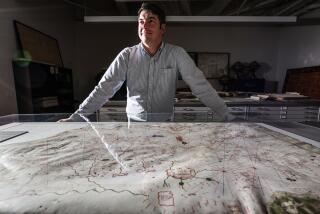Longing for spots that are no longer found on the map
You expect places to stay put. Once they’re on maps, they should remain there. But cartographers know hundreds of places that don’t exist anymore, from the tiny Krakatoan islets of Indonesia, all but wiped out in a volcanic eruption in 1883, to the vast U.S.S.R., which made anachronisms of atlases when it disbanded more than a decade ago.
“To a surprising extent, most places are incredibly persistent,” says Allen Carroll, chief cartographer for the National Geographic Society in Washington, D.C. “But the world is very dynamic.”
I would like to visit Prussia, for example, which has a long history but no longer exists on modern maps. Similarly, I want to see the majestic spires of Glen Canyon on the Colorado River in Utah, which were obliterated after the construction of Glen Canyon Dam; Tibet before the Chinese takeover; and scads of places in Eastern Europe I’ve read about but can’t find on maps: Pomerania, Volhynia, Bukovina, Courland, Bessarabia, all of which sound to my ear like the homelands of nutty dukes and counts in Marx Brothers movies. The more gone Bessarabia is, the more I want to see it.
That’s the romance of places off the map.
To console myself and better understand why places aren’t as permanent as I think they ought to be, I turned to geographers, who cite a variety of reasons that towns, countries, regions and geographical features disappear from maps, even though they may remain in history books and memory.
Natural disasters such as earthquakes, floods and volcanic eruptions have swept away such places as the Krakatoan islands and half of Santorini, now a crescent in the Aegean Sea edging the caldera of the volcano that formed the Greek island.
Norman Thrower, a professor emeritus of geography at UCLA, adds to the list the slowly encroaching ocean, which has engulfed coastal hamlets in southeastern England. When the tide goes in or out, you can still hear their old church bells ring, he says. Global warming, which is thought to be raising ocean levels, imperils low-lying islands and littorals from the North Atlantic to the South Pacific.
Places appear and disappear when hydroelectric facilities are built, damming rivers and creating lakes where there were once valleys. This explains in part why such projects are increasingly controversial among environmentalists. Some at the radical end of the spectrum would like to see Utah’s Glen Canyon Dam blown up, unleashing the once wild Colorado River and draining 186-mile-long Lake Powell.
Others rue the ongoing construction of the Three Gorges Dam in China. Expected to generate huge amounts of electricity and control flooding on the Yangtze River, it will also displace, destroy or diminish countless cities, towns, areas of natural beauty and history by the time it’s completed in 2009.
Author James Dickey turned the romance of lost places into high adventure with his novel “Deliverance.” In 1972 the book was made into an unforgettable movie, filmed on the Chattooga River between Georgia and South Carolina. In it, four weekend canoeists set off to run a river just before it’s dammed.
“This whole valley will be under water. But right now it’s wild.... We really ought to go,” says one of the characters in the novel, underscoring that wilderness and rapids are also obliterated by dams.
Through the years, cartographers have made mistakes, showing places on maps that never existed. Such is the case with Friesland, purportedly an island southwest of Iceland that persisted on charts from 1558 to the 1660s, when cartographers decided it was mythic and consigned it to the scrap box.
Politics and war above all change maps. East Germany and South Yemen surrendered their sovereignty in 1990; Tibet became a part of China by force in 1951. Bessarabia, bounded by the Dniester and Prut rivers in southeastern Europe, was part of the Roman Empire, Turkey, Russia and Romania before it changed hands again after the fall of the Soviet Union. To find where it was, you have to go to Moldavia and Ukraine.
There are 192 countries in the world, according to the National Geographic Society. Its count currently agrees with that of the U.S. State Department, though this isn’t always so. “Different organizations have different criteria for defining independent countries,” says David Miller, senior editor for National Geographic maps. “For us, an independent country needs to declare independence, control territory, demonstrate political stability and have international recognition.”
So goodbye, Bessarabia.
I know it’s still there because I think, dream and read about it. Call me romantic. I don’t care. I’m even holding out hope for Shangri-La, that lost lovely valley beyond the Karakoram Mountains where, in James Hilton’s 1933 novel, “Lost Horizon,” people live on and on.
It isn’t long life that compels me. It’s the idea that, while countries and cartographers come and go, there could be amazing places in the world that aren’t on maps because we don’t know they’re there.
*
The National Maritime Museum, Park Row, Greenwich, London, England, 011-44-20-8312-6565, www.nmm.ac.uk, is a good place to see old, now- erroneous globes.
“No Longer on the Map,” by Raymond H. Ramsay (Viking Press, 1972), tells the fascinating stories of places that once appeared on maps but never existed.






